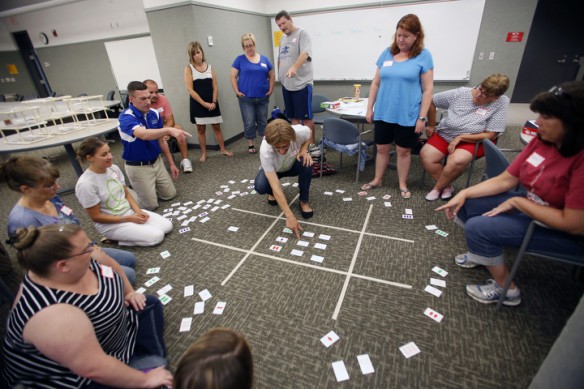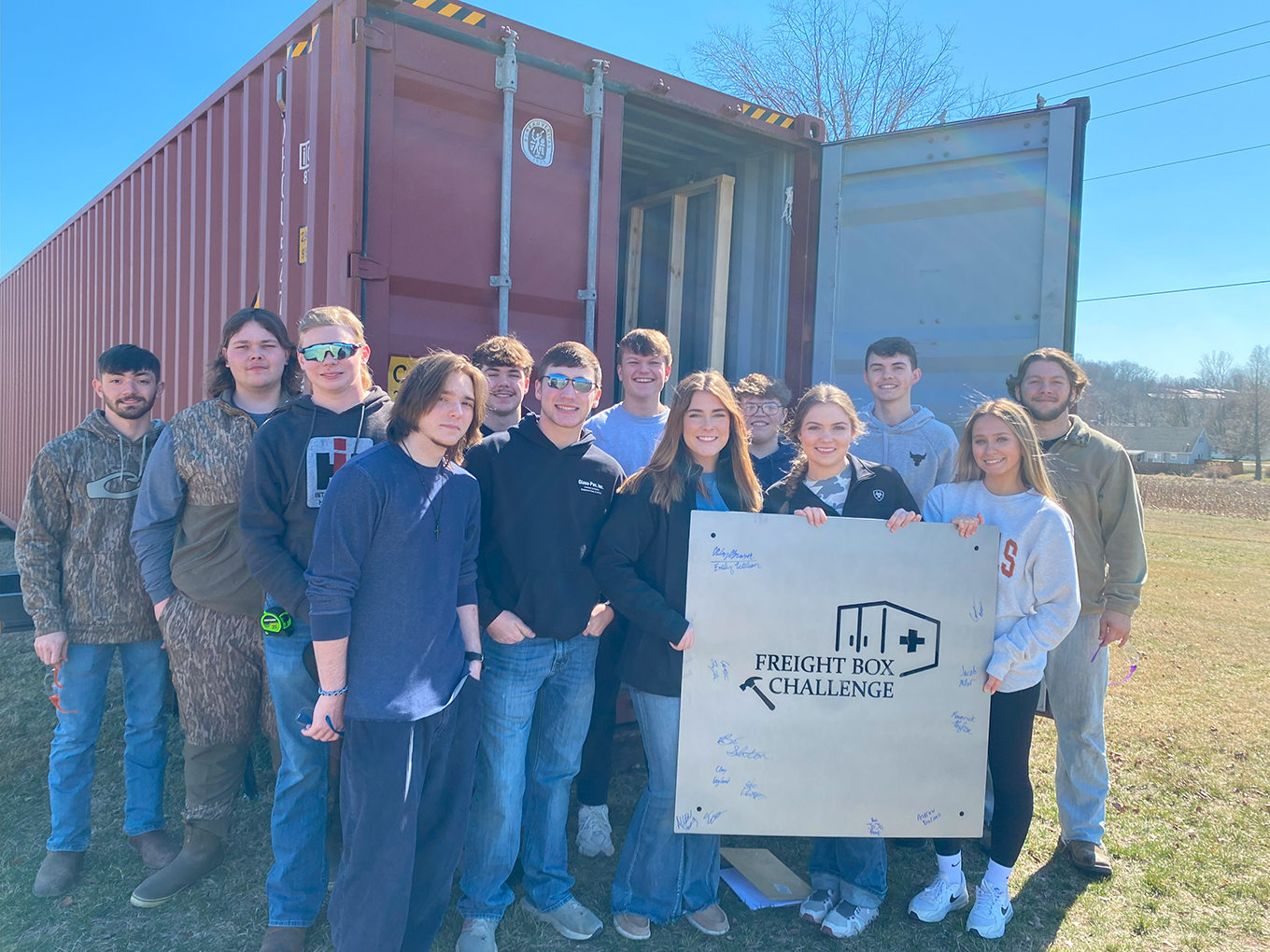
With the help of Northern Kentucky University assistant professor Aimee Krug, center, teachers create a giant board with the card game Set during the Math Teachers’ Circle at Northern Kentucky University.
Photo by Amy Wallot, July 20, 2015
By Brenna R. Kelly
brenna.kelly@education.ky.gov
Middle school students might think their math teachers sit around and do mathematics for fun – Fort Thomas Independent teacher Jill Terlau wants to prove them right.
Terlau, who teaches math at Highlands Middle School, has helped form the state’s first Math Teachers’ Circle.
“It’s all about creating a professional learning community centered on mathematics that is fun and meaningful at the same time,” said Terlau, who formed the circle’s leadership team with a fellow Highlands Middle teacher and two Northern Kentucky University mathematics professors.
The goal is to connect middle school math teachers, college professors and mathematics professionals to exchange ideas and work on rich mathematics problems together. The first Math Teachers’ Circle was formed in 2006 by the American Institute for Mathematics and there are now close to 80 active circles across the country. Like a book club for math, groups meet regularly to solve problems, share a meal and chat.
“This is supposed to be time for teachers to be mathematicians,” said Lisa Holden, an NKU associate math professor and part of the leadership team. “Teachers should discover mathematics just as they would like their students to do, so it’s important that they spend time discovering mathematics.”
More than 20 middle schools from nine northern Kentucky school districts recently spent five days at NKU for a workshop initiating them into the Northern Kentucky Math Teachers’ Circle. Each received a stipend and 20 professional development hours. They spent their days problem solving, doing recreational math problems and playing math games.
Tenisha Webb, an 8th-grade math teacher at Twenholfel Middle School (Kenton County), said being in the circle will allow her to hone her own mathematical thought processes which will benefit her students.
“Once you get your degree you don’t really have a chance for any type of math classes or math professional development, nothing to kind of keep you going or keep your skills in tune,” she said.
Doing math more often will make her a better teacher of math, she said.
“It puts me in the role of the student,” Webb said. “Because a lot of time as teachers we think, ‘This is the way I’m going to teach them and this is the way they are going to learn it.’ So it’s nice for you to be put in the role of student where you have to think of strategies to use or how might you try something differently. That way you can anticipate how your kids might do it or some of the strategies they might use.”
One exercise at the workshop expanded on the matching card game “Set.” Teachers started out playing the game, but then NKU Associate Mathematics Professor Aimee Krug showed them how to take it to the next level – actually four levels.
Krug showed the teachers how the cards could represent points on a line. Then she revealed three towers built from PVC, with the cards laid across three levels.
“We now have five points determining a four-dimensional hyperplane,” she said. “Set is very geometrical if you look at it that way.”
The teachers then played another game with the Set cards, laying them out in a tic-tac-toe board on the floor to represent lines on a one-dimensional plane. Other math exercises included logic problems and a game they could eat – the “Brownie Problem.”
In the “Brownie Problem,” teachers had to figure out how to divide a rectangular pan of brownies that was missing one rectangle in half. They had to come up with multiple solutions based on the location and the size of the missing piece.
“It’s so fun working with real mathematicians and learning from them,” Terlau said. “Teachers normally don’t get to do that.”
Terlau learned about math circles last year and then recruited the leadership team which also included a Fort Thomas administrator. The group spent week in California learning how to form a math circle and host the summer immersion workshop.
They then applied to NKU’s Center for Integrative Natural Science and Mathematics, which funded the majority of the workshop with help from the American Institute for Mathematics.
“I think it’s really important that math teachers have a community to lean on for support. We are all in this role because we love math, education and kids,” Terlau said. “The Math Teachers’ Circle feeds that love and passion. When we are around like-minded people we grow intellectually, spiritually and emotionally.”
The group plans to meet at least three times a semester to keep the math going. They will share food, drinks and problem-solving strategies. There will also be guest speakers such an executive from 84.51, a data analytics company in Cincinnati.
“We work on these intense logic problems and there are so many different ways you can take it, if you figure out something that is geometry based then you can take that Common Core content strand and build upon it,” Terlau said, “or the same problem can drift into algebra. It’s a circle.”
At the end of each workshop session, the group discussed how the games and problems solving exercises fit into the Kentucky Academic Standards for Math and how they would translate to the middle school classroom.
The teachers pointed out how they moved around the room while working on problems and playing games, how they shared strategies with each other, figured out problems by talking out loud and started simply with the Set game then made it much more complex.
“These are all the things we want to model in our classrooms,” Katherine Donelan, a math circle leader and Highlands math teacher, told the group.
Beechwood Elementary teacher Eric Fangman said he learned that working with other teachers while solving problems could improve his teaching.
“So many times we want our students to work like this and openly talk out loud and collaborate with each other and help each other work through problems,” he said, “so it’s really nice for us to able to think out loud.”
Aaron Lense, a 6th-grade math teacher at Highlands, said he planned to use all of the problem solving exercises he learned at the workshop in his classes.
“All math is, is problem solving. There are numbers involved and I think that kind of throws people off,” he said. “But if the kids learn to problem solve then I think we taught them math.”
MORE INFO….
Jill Terlau jill.terlau@forthomas.kyschools.us




Leave A Comment